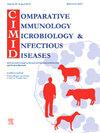孟加拉国首次报告牛同时感染出血性败血症和口蹄疫的病例
IF 2
3区 农林科学
Q4 IMMUNOLOGY
Comparative Immunology Microbiology and Infectious Diseases
Pub Date : 2024-10-29
DOI:10.1016/j.cimid.2024.102272
引用次数: 0
摘要
本研究旨在调查 2023 年 3 月至 12 月期间孟加拉国牛只爆发口蹄疫(FMD)病例时同时感染多杀性巴氏杆菌(P. multocida)B:2 型(多杀性巴氏杆菌可导致出血性败血症(HS))的情况。从 11 个不同的疫情爆发地区采集了共计 102 个样本。其中包括 54 份口蹄疫样本(唾液、组织上皮和病理组织,如肺、脾和心脏)和 54 份 HS 样本(鼻拭子和病理组织),这些样本来自 50 头不同年龄和性别的牛,它们都有疑似同时感染 HS 和口蹄疫的临床症状。样本处理后,使用通用引物和血清型特异引物进行逆转录酶聚合酶链式反应(RT-PCR),对 FMDV 及其血清型进行分子检测。通过各种培养基上的培养和形态学特征、革兰氏和亚甲基蓝染色、生化测试以及将分离物接种到小鼠体内的致病性测试,初步确定了引起 HS 的病原体--B:2 型多杀性猪嗜血杆菌。最后,通过使用特异引物进行 PCR 检测,确认了 B:2 型多杀菌细菌的分子检测结果。在 54 份疑似口蹄疫样本中,有 45 份(83%)的口蹄疫病毒检测呈阳性,其中 53% 为血清型 "O",17% 为血清型 "A",6% 为混合血清型 "O "和 "A"。在 FMDV 阳性的样本中,有 17 份(38%)疑似 HS 样本检测出同时感染了 B:2 型多杀菌素。这项研究表明,FMDV 引起的牛急性免疫抑制可导致并发感染并发症,尤其是由 B:2 型多杀性白喉杆菌引起的并发感染,从而导致在发生 FMD 的同时发生 HS。本文章由计算机程序翻译,如有差异,请以英文原文为准。
The first report of concurrent infection of hemorrhagic septicemia with foot and mouth disease in cattle in Bangladesh
This study aimed to investigate the concurrent infection of Pasteurella multocida (P. multocida) type B:2, which causes Hemorrhagic Septicemia (HS), with cases of Foot and Mouth Disease (FMD) outbreaks in cattle in Bangladesh between March and December 2023. Samples were collected from 11 distinct outbreak areas, totaling 102 samples. These included 54 FMD samples (saliva, tissue epithelium, and morbid tissues such as lung, spleen, and heart) and 54 HS samples (nasal swabs and morbid tissues) from 50 cattle of various ages and sexes, all showing clinical signs of suspected concurrent HS and FMD infection. After sample processing, molecular detection of FMDV and its serotypes was performed using Reverse Transcriptase PCR (RT-PCR) with universal and serotype-specific primers. The HS-causing agent, P. multocida type B:2, was initially identified through cultural and morphological characteristics on various media, followed by Gram’s and methylene blue staining, biochemical tests, and pathogenicity tests through inoculation of isolates into mice. Finally, molecular detection of P. multocida type B:2 was confirmed using PCR with specific primers. Forty-five (83 %) of the 54 FMD suspected samples tested positive for FMDV, with 53 % of these positive for serotype ‘O,’ 17 % for serotype ‘A,’ and 6 % for mixed serotypes ‘O’ and ‘A.’ Among the FMDV-positive samples, 17 (38 %) of the HS-suspected samples tested positive for concurrent infection with P. multocida type B:2. The study reveals that FMDV-induced acute immunosuppression in cattle can lead to complications from concurrent infections, particularly those caused by P. multocida type B:2, resulting in HS alongside FMD.
求助全文
通过发布文献求助,成功后即可免费获取论文全文。
去求助
来源期刊
CiteScore
4.60
自引率
0.00%
发文量
102
审稿时长
40 days
期刊介绍:
Comparative Immunology, Microbiology & Infectious Diseases aims to respond to the concept of "One Medicine" and to provide a venue for scientific exchange. Based on the concept of "Comparative Medicine" interdisciplinary cooperation between specialists in human and animal medicine is of mutual interest and benefit. Therefore, there is need to combine the respective interest of physicians, veterinarians and other health professionals for comparative studies relevant to either human or animal medicine .
The journal is open to subjects of common interest related to the immunology, immunopathology, microbiology, parasitology and epidemiology of human and animal infectious diseases, especially zoonotic infections, and animal models of human infectious diseases. The role of environmental factors in disease emergence is emphasized. CIMID is mainly focusing on applied veterinary and human medicine rather than on fundamental experimental research.

 求助内容:
求助内容: 应助结果提醒方式:
应助结果提醒方式:


